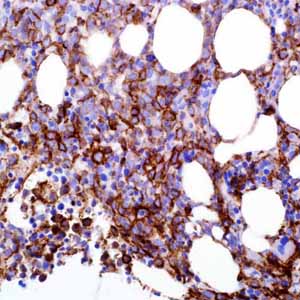
CD13 (SP187)

CD13 (aminopeptidase-N) is a transmembrane protease present in many tissues and cell types (e.g., endothelial and epithelial cells, fibroblasts, and leukocytes).1 CD13 is overexpressed in various solid and hematological malignancies in humans, including acute myeloid leukemia (AML), and is thought to influence tumor progression. Acute promyelocytic leukemia, hypogranular variant, poses difficulties in morphologic interpretation for separation from other subtypes of AML.2 CD13 is overexpressed in the tumor and is useful in diagnosing this variant by using a panel including antibodies against CD13(+), CD34(+), CD117(+), CD16(-), and CD33(+).3 Myeloid sarcoma (also called chloroma, extramedullary sarcoma, or granulocytic sarcoma) is essentially a solid tumor composed of myeloblasts or immature myeloid cells in an extramedullary site. It can be isolated or occur during the course of AML, chronic myeloid leukemia, myelodysplastic syndrome, or myeloproliferative neoplasias. Myeloid sarcoma should be distinguished from large cell lymphoma, lymphoblastic lymphoma, Burkitt lymphoma, undifferentiated carcinoma, malignant melanoma, extra-medullary hematopoiesis, and inflammation.4 Immunochemical analyses are needed for the accurate diagnosis of myeloid sarcoma.4 CD13 is overexpressed in myeloid sarcoma and anti-CD13 is very useful in diagnosing myeloid sarcoma using a panel including antibodies against CD34, CD43, CD117, MPO, lysozyme, CD163 and CD68.4 It has been reported5 that CD13 is expressed in both normal and neoplastic liver tissue, where it exhibits a canalicular distribution pattern similar to that seen for polyclonal CEA and CD10. Thus, anti-CD13 can be useful as an additional marker in differentiating between HCC and non-hepatocellular neoplasms.5
